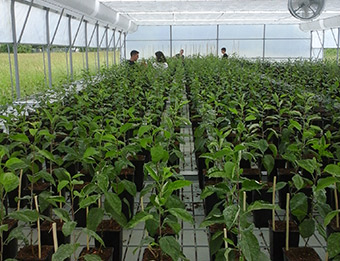Two secondary schools in the Pannonia lowland border area of Hungary and Croatia joined forces with local foresters to save and revive a number of fruit tree species native to the region. The ‘Forgotten Forest Fruit Trees’ project helped modernise the process of breeding, planting and cultivating a variety of trees including rare apple and pears, checker trees, sorbs and sweet cherries. As part of the project’s activities, a joint forestry curriculum has been introduced to the Technical School of Virovitica in Croatia and Dráva Völgye school in Barcs, Hungary.
Saving forgotten forest fruit trees in Hungary and Croatia
- 22 March 2019
The project ‘Forgotten Forest Fruit Trees’ has connected two forestry schools from Croatia and Hungary. In this way we have achieved a common goal of preserving rare and forgotten forest fruit trees. The result is a modern greenhouse and nursery where several thousand forest seedlings have been grown, which will be planted in Croatia and Hungary. ‘Preserve, and not forget’: a sentence which, in the full sense of the word, makes this project important and noble in preserving what is left of us – The only planet earth.
The fruit trees are considered important natural assets to the area and its biodiversity. As well as being a healthy and nutritious part of people’s diet, they are an important food source to the local deer population. If the deer were to run out of these fruit, they would likely eat and damage agricultural crops to make up the shortfall.
The project helped develop a seed collection for the trees and paid for the construction of a 360 m2 greenhouse and all the tools necessary for the cultivation of the seedlings. Both schools were provided with the equipment required to nurture the seeds and grow new trees.
Learning experience
Teachers at the two schools took part in 19 training courses to learn about the trees and their importance to the area. They passed on what they learned to students who participated in the project. At the same time, both teachers and students explored and solved problems relating to the local ecosystem and the importance of preserving the region’s biodiversity.
In all, more than 200 people participated in joint educational activities and related events, which included hosting exhibitions and displays designed to raise awareness about the project and the importance of the trees.
Video
Forgotten Forest Fruit TreesTotal investment and EU funding
Total investment for the project “Forgotten Forest Fruit Trees” is EUR 160 096, with the EU’s European Regional Development Fund contributing EUR 136 081 through the “Interreg V-A Hungary-Croatia” Co-operation Programme for the 2014-2020 programming period. The investment falls under the priority “4 Education”.

